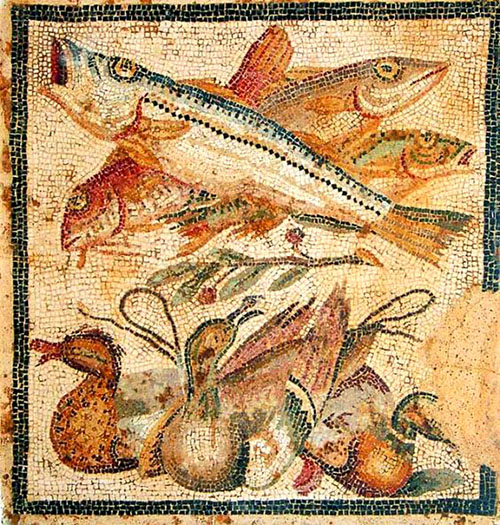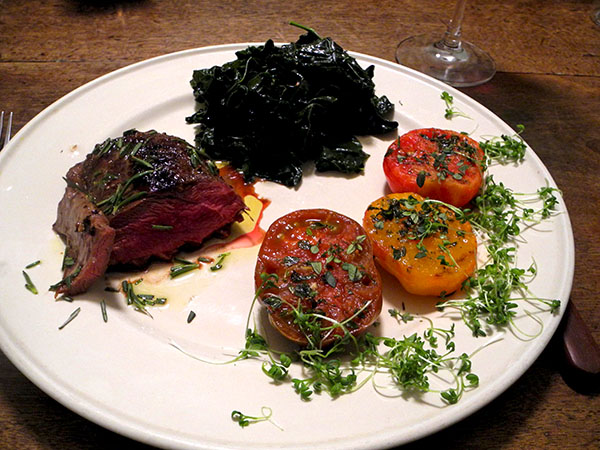
Duck: Fish or fowl? Sometimes it’s been both.
The image above is from Pompei, and while I don’t mean to suggest that the Romans confused waterfowl and seafish, I find it amusing that some later Europeans did.

We’ve been feasting on a lot of fish lately, and even on Wednesday, the night following this meal featuring pan-fried duck breast, when I had a night away from the kitchen, there was seafood. As almost always, it came from New York waters; as almost never, we sat at a long communal table, outside, at dusk, just a block from the Hudson. The venue was Michael Anthony‘s restaurant, Untitled, the dish, cioppino, the terrific main course of a farmer’s dinner which otherwise almost exclusively featured the very fine vegetables of Alewife Farm.
On Tuesday, the day before, we had enjoyed an entrée of duck breast at home, which means I did not prepare seafood. But wait! In some circles duck is considered fish, or at least that was the case during a time when the consumption of fish was a weighty concern through much of the Western world.
Medieval catholics would often really stretch the definition of ‘fish’ in order to be able to enjoy more of their favorite foods on Fridays or fast days, and the duck was considered to be in that category, as was other aquatic life such as geese, puffins, dolphins, and whales. As late as the 17th century, at least in Quebec, the Church officially declared that the beaver, as an aquatic animal and a skilled swimmer, was actually a fish [apparently arguing from “..the ‘Summa Theologica‘ of Thomas Aquinas, which bases animal classification as much on habit as anatomy.“].
I could go on, and, because I had been a Catholic as a child, and have always been interested in every aspect of food, I will. Young rabbits were considered fish and not meat (I do not know why), as were frogs, snakes, and (as of a Louisiana 2010 episcopal decree) alligators.
So we had duck. It didn’t seem at all like fish. It definitely didn’t feel like a fast day.
- one 13-ounce duck breast from Hudson Valley Duck Farm, the fatty side scored in tight cross hatching with a very sharp knife, the entire breast then sprinkled top and bottom with a mixture of sea salt, freshly-ground black pepper, and a little turbinado sugar, left standing for about 40 minutes before it was pan-fried inside a small oval enameled cast iron pan over medium heat, the fatty side down first, for a total of 8 or 9 minutes, turning once, draining the oil part of the way through [to be strained and used in cooking later, if desired], removed when medium rare (cutting it into 2 portions to confirm that the center was of the right doneness), left to sit for several minutes before being finished with a drizzle of juice from an organic lemon from Whole Foods Market, then a little chopped rosemary from Phillips Farm and a drizzle of olive oil
- three halved heirloom tomatoes from Tamarack Hollow Farm, brushed with dried Sicilian oregano and fresh thyme from Stokes Farm, sea salt, freshly-ground black pepper, and olive oil, then pan grilled, arranged on two plates, lemon peppercress scattered around the edges
- cavalo nero (or lacinato or Tuscan cabbage) from Paffenroth Farms, wilted briefly in olive oil in which one clove of Rocambole garlic from Keith’s Farm had first been heated until pungent, seasoned with sea salt and freshly-ground black pepper, drizzled with a little more oil
- the wine was a California (Sonoma) red, Ana Diogo-Draper Cabernet Sauvignon Sonoma County 2015, from Naked wines
- the music was the album, ‘Wassenaer: 6 Concerti Armonici‘, Richard Jenkinson conducting the Innovation Chamber Ensemble in music of the Dutch diplomat, composer and governing official, Unico Graf Van Wassenaer, composed in 1740
[the image at the top is from the Milan Museum Guide]